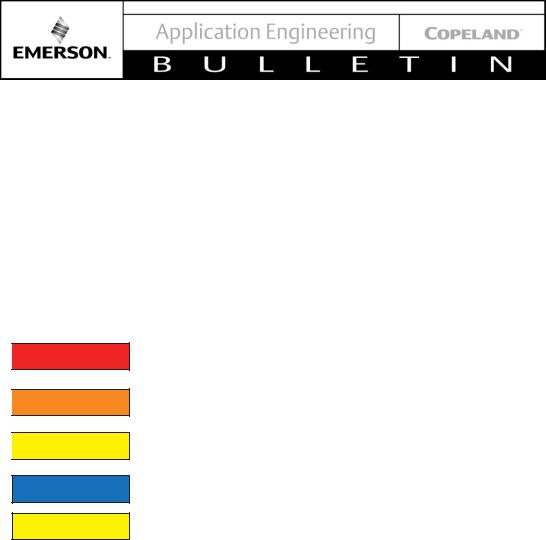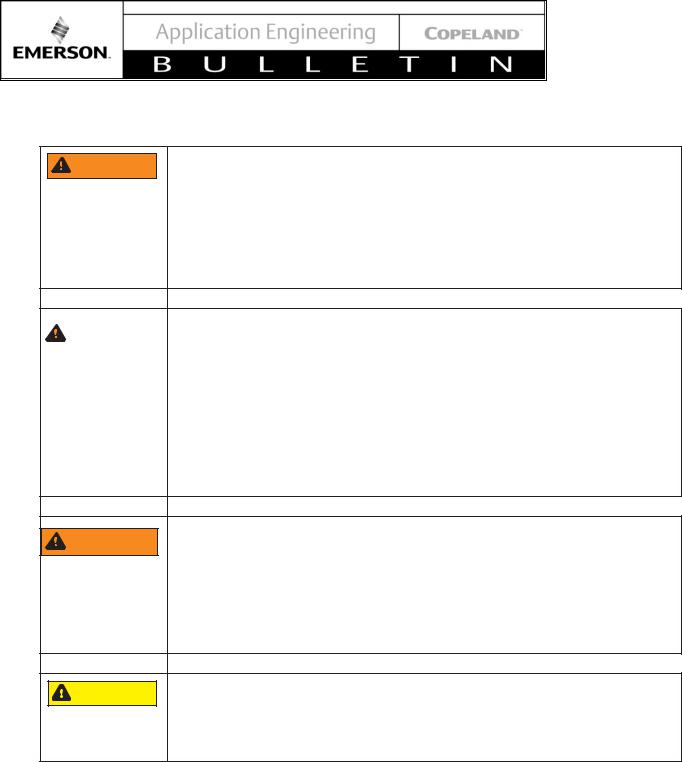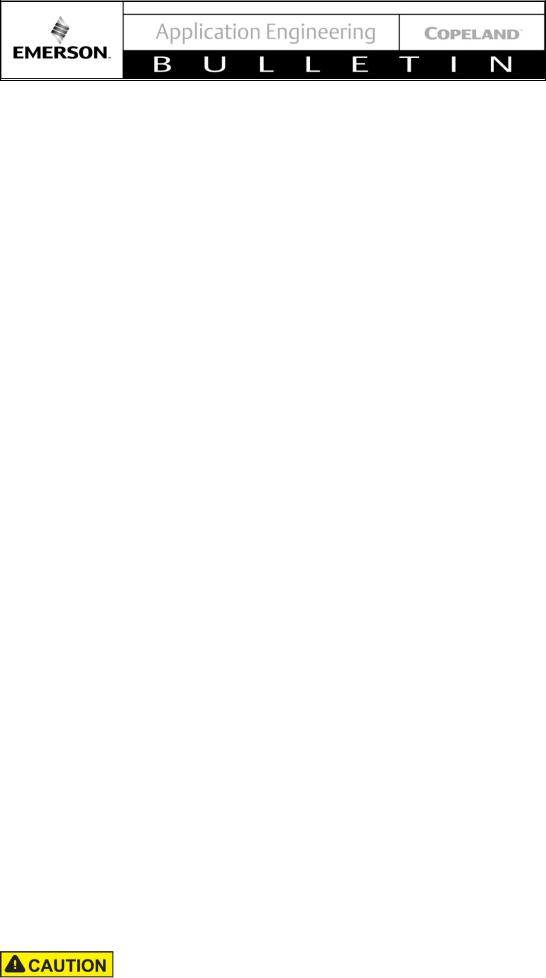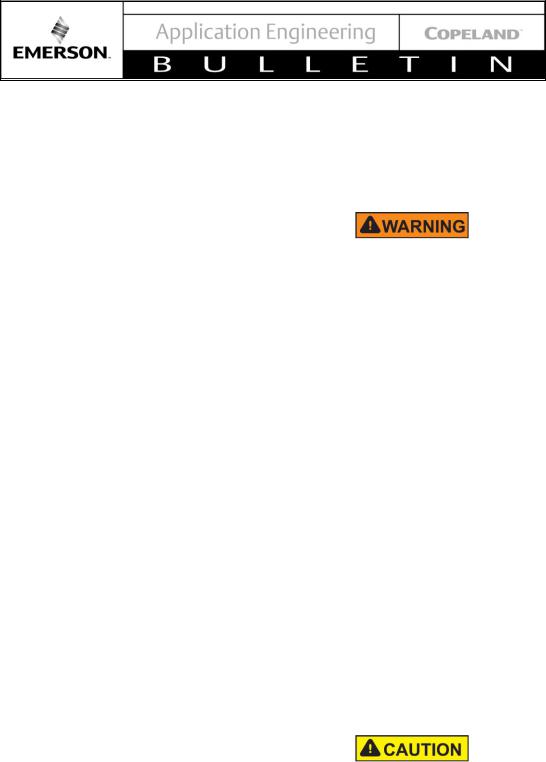Emerson ZPV066, ZPV096 User Manual

AE4-1414 R2 |
September 2019 |
ZPV066 & ZPV096 Copeland Scroll™ Variable Speed Compressors
TABLE OF CONTENTS |
|
Safety |
|
Safety Instructions ....................................................... |
2 |
Instructions Pertaining to Risk of Electrical |
|
Shock, Fire, or Injury to Persons ............................... |
3 |
INTRODUCTION ......................................................... |
4 |
Product Description...................................................... |
4 |
Compressor Data ......................................................... |
4 |
Power Supply ............................................................... |
4 |
Nomenclature............................................................... |
4 |
Agency Approval .......................................................... |
4 |
OEM LAB TESTING.................................................... |
4 |
Modeling System Performance.................................... |
4 |
COMPRESSOR DESIGN FEATURES........................ |
4 |
Compressor Motor ....................................................... |
4 |
Oil Pump ...................................................................... |
4 |
APPLICATION CONSIDERATIONS ........................... |
5 |
Variable Speed Drive Options...................................... |
5 |
Third Party Drive .......................................................... |
5 |
Emerson EVC Drive Features...................................... |
5 |
Oil Boost....................................................................... |
5 |
Motor Protection........................................................... |
5 |
Missing Phase Protection ............................................ |
5 |
Short Cycle Protection ................................................. |
5 |
Resonance Avoidance Feature ................................... |
5 |
Discharge Temperature Protection .............................. |
5 |
Emerson EVC Operating Envelope ............................. |
5 |
Emerson EVC Starting and Stopping Routine ............. |
5 |
Other Features ............................................................. |
5 |
Emerson EVC Drive and Variable |
Speed |
Scroll Set-Up ................................................................ |
6 |
Refrigerant ................................................................... |
6 |
Operating Envelope ..................................................... |
6 |
High Pressure Control.................................................. |
6 |
Low Pressure Control .................................................. |
6 |
Discharge Temperature Protection .............................. |
6 |
Motor Overload Protection ........................................... |
7 |
Oil Type........................................................................ |
7 |
Maximum Tilt Angle ..................................................... |
7 |
Contaminant Control .................................................... |
7 |
Refrigerant Piping ........................................................ |
7 |
Long Pipe Lengths / High Refrigerant Charge............. |
7 |
Discharge Check Valve................................................ |
8 |
Suction and Discharge Tube Design ........................... |
8 |
Compressor Mounting.................................................. |
8 |
Discharge Mufflers ....................................................... |
8 |
Airborne Sound Control ............................................... |
9 |
Expansion Devices ...................................................... |
9 |
Reversing Valves ......................................................... |
9 |
|
1 |
© 2017 Emerson Climate Technologies, Inc. |
|
Accumulators................................................................ |
9 |
Off-Cycle Migration Control .......................................... |
9 |
Manifolded Compressors ........................................... |
10 |
Manifolded Applications ............................................. |
10 |
APPLICATION TESTS .............................................. |
11 |
General Application Tests .......................................... |
11 |
ASSEMBLY LINE PROCEDURES............................ |
11 |
Installing the Compressor........................................... |
11 |
Assembly Line Brazing Procedure ............................. |
11 |
Pressure Testing ........................................................ |
11 |
Assembly Line System Charging Procedure.............. |
11 |
Hipot (AC High Potential) Testing .............................. |
12 |
Final Run Test ............................................................ |
12 |
Unbrazing System Components................................. |
12 |
SERVICE PROCEDURES ......................................... |
12 |
Electrical Troubleshooting .......................................... |
12 |
Compressor Replacement After a Motor Burn ........... |
13 |
Start-Up of a New or Replacement Compressor........ |
13 |
FIGURES & TABLES |
|
Figure 1 - Compressor Nomenclature ........................ |
14 |
Figure 2 - EV Nomenclature....................................... |
14 |
Figure 3 - Oil Dilution Chart ........................................ |
15 |
Figure 4 - Scroll Suction Tube Brazing....................... |
16 |
Figure 5 - How Scroll Works....................................... |
17 |
Figure 6 - Discharge Thermostat................................ |
18 |
Figure 7 - Cross Sectional View ................................. |
18 |
Figure 8 - Electrical Nomenclature for Multiples ........ |
19 |
Figure 9 - Start Up Procedure .................................... |
20 |
Figure 10 - Shut Down Procedure.............................. |
20 |
Table 1 - Compressor Accessories & |
|
Service Parts .............................................................. |
21 |
Table 2 - Compressor Motor Specification ................. |
22 |
Table 3 - Compressor & Drive Selection .................... |
22 |
Table 4 - Compressor Refrigerant Charge |
|
Limits .......................................................................... |
23 |
Table 5 - Speed Adjustment....................................... |
23 |

AE4-1414
Safety Instructions
Copeland Scroll™ compressors are manufactured according to the latest U.S. and European Safety Standards. Particular emphasis has been placed on the user's safety. Safety icons are explained below and safety instructions applicable to the products in this bulletin are grouped on Page 3. These instructions should be retained throughout the lifetime of the compressor. You are strongly advised to follow these safety instructions.
Safety Icon Explanation

 DANGER
DANGER

 WARNING
WARNING

 CAUTION
CAUTION
NOTICE
CAUTION
DANGER indicates a hazardous situation which, if not avoided, will result in death or serious injury.
WARNING indicates a hazardous situation which, if not avoided, could result in death or serious injury.
CAUTION, used with the safety alert symbol, indicates a hazardous situation which, if not avoided, could result in minor or moderate injury.
NOTICE is used to address practices not related to personal injury.
CAUTION, without the safety alert symbol, is used to address practices not related to personal injury.
2
© 2017 Emerson Climate Technologies, Inc.

AE4-1414
Instructions Pertaining to Risk of Electrical Shock, Fire, or Injury to Persons
WARNING |
ELECTRICAL SHOCK HAZARD |
|
• Disconnect and lock out power before servicing. |
||
|
•Discharge all capacitors before servicing.
•Use compressor with grounded system only.
•Molded electrical plug must be used when required.
•Refer to original equipment wiring diagrams.
•Electrical connections must be made by qualified electrical personnel.
•Failure to follow these warnings could result in serious personal injury.
|
PRESSURIZED SYSTEM HAZARD |
|
WARNING |
||
• System contains refrigerant and oil under pressure. |
||
|
|
•Remove refrigerant from both the high and low compressor side before removing compressor.
•Never install a system and leave it unattended when it has no charge, a holding charge, or with the service valves closed without electrically locking out the system.
•Use only approved refrigerants and refrigeration oils.
•Personal safety equipment must be used.
•Failure to follow these warnings could result in serious personal injury.
WARNING |
BURN HAZARD |
• Do not touch the compressor until it has cooled down. |
•Ensure that materials and wiring do not touch high temperature areas of the compressor.
•Use caution when brazing system components.
•Personal safety equipment must be used.
•Failure to follow these warnings could result in serious personal injury or property damage.
CAUTION |
COMPRESSOR HANDLING |
|
• Use the appropriate lifting devices to move compressors. |
||
|
•Personal safety equipment must be used.
•Failure to follow these warnings could result in personal injury or property damage.
Safety Statements
•Refrigerant compressors must be employed only for their intended use.
•Only qualified and authorized HVAC or refrigeration personnel are permitted to install commission and maintain this equipment.
•Electrical connections must be made by qualified electrical personnel.
•All valid standards and codes for installing, servicing, and maintaining electrical and refrigeration equipment must be observed.
3
© 2017 Emerson Climate Technologies, Inc.

AE4-1414
INTRODUCTION
This bulletin provides instructions on how to apply a Copeland Scroll™ variable speed compressor in a safe and reliable manner. The Copeland Scroll variable speed compressor will be referred to throughout this bulletin as the 'variable speed scroll' or the 'compressor.'
Product Description
ZPV066 and ZPV096 variable speed compressors are intended for use in commercial air conditioning, chiller, and heat pump applications. The variable speed scrolls utilize three-phase brushless permanent magnet (BPM) motors. The compressors have been qualified for use with Emerson™ EVC Drives which have been developed and qualified for BPM motor-compressors. The Emerson drives offer the highest level of compressor protection through the use of CoreSense™ protection algorithms. If use of a non-Emerson drive is desired, please work with Application Engineering to select an appropriate drive for the compressor application. See Third Party Drive requirements on the following page.
Compressor Data
Compressor mechanical, electrical, and performance data are available online in Online Product Information at Emerson.com/OPI. From this site, compressor drawings (PDF format) can be downloaded. Other drawing formats (IGES, DXF, and STP) can be obtained by contacting your Application Engineer.
Other performance data available to the system designer includes sound, vibration, and coefficient data for the polynomial equation used to represent tabular performance data.
Power Supply
The compressor and drive are an integral and optimized combination. The drive will convert the input voltage into a variable frequency and voltage to power the compressor. For more information on the drive power input requirements please see the Emerson EVC Drive user guide.
Ensure correct wiring at both the compressor and drive connections prior to starting the compressor to avoid a mis-wire or powered reverse situation. These situations may cause compressor damage.
4
The variable speed compressor must be paired with the appropriate variable speed drive. Do not connect the power supply directly to the compressor.
Nomenclature
The model number of the variable speed scroll includes the approximate displacement in cubic centimeters per revolution. Figure 1 provides a complete explanation of all of the alpha and numeric characters in the compressor model number.
Agency Approval
ZPV066 and ZPV096 compressors are U.L. recognized in file SA2337, Volume 22. When the compressor is used with the Emerson EVC, the compressor and drive are a U.L. listed 508C package. The package is listed in file SA2337, Volume 22.
OEM LAB TESTING
Application Engineering should be consulted during the design, development, and production launch of the variable speed system to help ensure that the variable speed scroll is applied as intended, in a safe and reliable manner.
Modeling System Performance
Modeling at any speed range in the approved envelope is facilitated by 20 coefficient data available from Application Engineering.
COMPRESSOR DESIGN FEATURES
The variable speed scroll has a number of design features that improve efficiency and reliability. Figure 7 shows the internal features that are unique to the variable speed scroll.
Compressor Motor
The brushless permanent magnet (BPM) motor in the variable speed scroll consists of a three-phase stator and a rotor embedded with high energy permanent magnets. The input voltage is a series of pulses of varying frequency at 120 degree intervals between phases.
Oil Pump
The variable speed scroll is equipped with an oil pump to ensure an adequate supply of oil to the bearing system throughout the operating speed range.
© 2017 Emerson Climate Technologies, Inc.

AE4-1414
APPLICATION CONSIDERATIONS Compressor Temperature Protection
A discharge line thermistor must be used to protect the compressor. The drive will shut down the compressor when the thermistor temperature exceeds 275°F (135°C). Please see the section Troubleshooting Scroll Temperature Trip for more information on the discharge line thermistor. Refer to Table 1 for more information.
Variable Speed Drive Options Third Party Drive
The customer may use a third party drive. A third party control system must include: a discharge line thermistor that will signal the drive to shut down if the temperature exceeds 275°F (135°C), a soft start and stopping routine, an oil boost cycle similar to the Emerson EVC oil boost, and include the operating envelope. A third party drive must include short cycle protection similar to the Emerson EVC short cycle protection. Refer to Table 2 for compressor motor specifications and Table 5 for speed adjustment requirements.
Emerson EVC Drive Features
It's recommended that the Emerson variable speed drive (VSD) be used with the variable speed compressor. The Emerson VSD has custom built in features that may improve the longevity of the compressor and efficiency of the system. Refer to the Emerson EVC Drive user guide for more information.
Oil Boost
The Emerson EVC drive includes an oil boost cycle when the compressor operates at less than 1800 RPM. The oil boost cycle starts once the compressor operates for two hours at less than 1800 RPM. During the oil boost cycle, the drive forces the compressor to run for five minutes at 3600 RPM. After operating for five minutes at 3600 RPM, the drive allows the compressor to operate at less than 1800 RPM. The operating envelope shows the operating conditions of the oil boost cycle.
Motor Protection
The Emerson EVC drive includes motor protection features for the compressor. The drive sets the maximum current limit, low voltage fold back which allows the compressor to ride through low voltage situations, which helps keep the compressor running to avoid nuisance trips. The drive also includes lost rotor avoidance and locked rotor
5
detection. The lost rotor avoidance uses a custom algorithm to evade a speed error by reducing the speed by 200 RPM to 're-catch' the rotor.
Missing Phase Protection
The Emerson EVC drive includes compressor missing phase protection. The drive checks for a missing phase connection.
Short Cycle Protection
The Emerson EVC drive includes short cycling protection which checks the duration of the runtime and quantity of short cycles. The amount of runtime and the maximum allowable short cycles in 24 hours is adjustable. The default maximum short cycles in 24 hours is four. The default short cycle time is five minutes.
Resonance Avoidance Feature
The Emerson EVC drive includes a resonance avoidance feature which has the ability to skip a single frequency or a range of frequencies.
Discharge Temperature Protection
The thermistor will signal the drive to shut down if the temperature exceeds 275°F (135°C).
Emerson EVC Operating Envelope
When using the Emerson EVC drive, the compressor is designed to operate within the requirements of the operating envelope.
Emerson EVC Starting and Stopping Routine
The drive controls the starting and stopping routine of the variable speed scroll. This routine allows soft starting and controlled stopping, an advantage over traditional on-off control of fixed capacity units. Please refer to the Emerson EVC drive user guide for an exact explanation of the starting and stopping process.
The variable speed scroll compressor incorporates a fluid brake design to help mitigate reverse rotation during shutdown. A momentary reverse rotation sound may be heard. Refer to Table 5 for more information.
Other Features
Refer to the Emerson EVC drive user guide for more features and functions of the drive.
© 2017 Emerson Climate Technologies, Inc.

AE4-1414
Emerson EVC Drive and Variable Speed Scroll Set-Up
A quick start guide is available with the Emerson EVC drive. Application Engineering is available to assist during any part of this process.
Refrigerant
For applications where the voltage is below the rated minimum voltage, the drive speed may be limited. The limitation may also be affected by the ambient temperature.
High Pressure Control
ZPV066 and ZPV096 compressors are approved for |
A high pressure control must be used in all |
|
||||||||||||||||
use with R-410A only. Use of refrigerants other than R- |
|
|||||||||||||||||
applications. |
|
|||||||||||||||||
410A voids the UL recognition of these compressor |
|
|||||||||||||||||
|
|
|||||||||||||||||
models |
since |
the |
motor |
overload |
system could |
be |
A high pressure control must be used with these |
|||||||||||
adversely affected. |
|
|
|
|
|
|
|
|
|
|
|
|||||||
|
|
|
|
|
|
|
|
|
|
|
compressors since they do not employ an internal |
|||||||
|
|
|
|
|
|
|
|
|
|
|
|
|
|
|
|
|||
Operating Envelope |
|
|
|
|
|
|
|
|
|
pressure relief valve (IPR). The maximum cut-out |
||||||||
|
|
|
|
|
|
|
|
|
setting must not exceed 650 psig (45 bar). The switch |
|||||||||
The compressor operating envelope at each speed |
should be wired in series with the unit contactor to |
|||||||||||||||||
represents the allowable range of operating |
immediately stop compressor operation if there is a |
|||||||||||||||||
conditions for the compressor at the superheat and |
high pressure event. The high pressure control should |
|||||||||||||||||
subcooling values defined on the envelope. The most |
have a manual reset feature for the highest level of |
|||||||||||||||||
current and updated operating envelopes can be |
system protection. If an auto reset high pressure |
|||||||||||||||||
accessed in Online Product Information at |
control is used, the compressor should be locked out |
|||||||||||||||||
Emerson.com/OPI. Contact Application Engineering |
after three consecutive trips. If a pressure transducer is |
|||||||||||||||||
if desired to operate at different speeds than |
used to protect against high discharge pressure events |
|||||||||||||||||
published in the operating envelope. |
|
|
|
|
|
the transducer and control logic should comply with |
||||||||||||
|
|
|
|
|
|
|
|
|
|
|
|
|
|
|
|
U.L. and/or local safety requirements. |
|
|
Operating |
|
the |
|
compressor |
at |
evaporating |
|
|
||||||||||
temperatures that are higher than those specified in |
Low Pressure Control |
|
||||||||||||||||
the envelopes |
for |
the given |
speed will |
|
result |
in a |
|
|||||||||||
|
A low pressure control is required to protect against |
|||||||||||||||||
higher oil circulation rate. A higher oil circulation rate |
||||||||||||||||||
loss of charge and other system fault conditions that |
||||||||||||||||||
can reduce |
heat exchanger |
efficiency and possibly |
||||||||||||||||
can lead to compressor overheating. A low pressure |
||||||||||||||||||
result |
in |
oil |
pump-out |
if |
|
the |
system |
has |
long |
|||||||||
|
cut-out switch located in the suction line with a cut-out |
|||||||||||||||||
interconnecting piping. |
Customers that |
|
choose |
to |
||||||||||||||
|
setting no lower than 20 psig (1.4 bar) is required in all |
|||||||||||||||||
operate in |
|
these |
higher |
evaporating |
temperature |
|||||||||||||
|
heat pump applications. For air conditioning |
units, a |
||||||||||||||||
areas should use a compressor sample with a sight- |
||||||||||||||||||
cut-out setting no lower than 55 psig (3.8 |
bar) will |
|||||||||||||||||
tube during |
system |
development |
testing |
to |
ensure |
|||||||||||||
adequately protect against most low pressure faults. A |
||||||||||||||||||
that an adequate |
level |
of |
oil is |
maintained |
in |
|
the |
|||||||||||
|
higher level of protection for air conditioning units can |
|||||||||||||||||
compressor |
sump. |
Sight-tubed |
compressors |
|
for |
|||||||||||||
|
be realized if the cut-out setting is increased to 95 psig |
|||||||||||||||||
monitoring |
the |
oil |
level |
are |
available by |
contacting |
||||||||||||
(6.6 bar) to prevent evaporator coil icing. |
|
|||||||||||||||||
Application Engineering. |
|
|
|
|
|
|
|
|
|
|
||||||||
|
|
|
|
|
|
|
|
|
|
|
||||||||
The lower right boundary of the operating envelope is the minimum compression ratio required to keep the scrolls loaded. Operation below this boundary could result in the compressor intermittently loading and unloading and noisy operation.
The upper left boundary of the envelope represents the maximum compression ratio when operating with 20F° (11°C) suction superheat. If the operating condition approaches this boundary of the envelope the compressor discharge temperature will begin to approach the maximum scroll temperature allowed by the discharge line thermistor.
If operating the compressor below 1800 RPM, an oil boost cycle is required. Refer to the note in the operating envelope.
Discharge Temperature Protection
Compressor top cap temperatures can be very hot. Care must be taken to ensure that wiring or other materials which could be damaged by these temperatures do not come into contact with these potentially hot areas.
ZPV066 and ZPV096 compressors do not have an internal discharge gas temperature protection. In order for the variable speed drive to operate properly a thermistor should be attached to the compressor discharge line as close as possible and less than 6'' (15cm) from the compressor discharge fitting. The thermistor is designed for a 7/8" (22 mm) line and
6
© 2017 Emerson Climate Technologies, Inc.

AE4-1414
should be properly insulated. See Table 6 of AE-1328 for thermistor temperature vs resistance values. Refer to Table 1 for part numbers of discharge line thermistors. Figure 6 illustrates the discharge thermistor.
Motor Overload Protection
The drive will provide motor over current protection in the event the compressor becomes mechanically locked or if the load on the compressor motor is abnormally high. The input power supply to the drive must be properly fused.
The molded plug power connection option is not available for the 208/230 volt ZPV0962E-5*9 compressor due to the current limit of the molded plug power cable.
Oil Type
The variable speed scrolls are charged with polyol ester (POE) oil. See the compressor nameplate for the original oil charge. A complete recharge should be approximately four fluid ounces (118cc) less than the nameplate value. Copeland™ Ultra 32-3MAF, available from Emerson Wholesalers, should be used if additional oil is needed in the field. Mobil Arctic EAL22CC, Emkarate RL22, Emkarate 32CF and Emkarate 3MAF are acceptable alternatives.
CAUTION! POE oil must be handled carefully and the proper protective equipment (gloves, eye protection, etc.) must be used when handling POE lubricant. POE must not come into contact with any surface or material that might be harmed by POE, and spills should be cleaned up quickly with paper towels, soap and water.
Maximum Tilt Angle
Applications, such as transportation air conditioning or mobile radar applications, may require the compressor to operate at some angle from vertical. Service personnel may be required to maneuver a unit through a stairwell or other cramped area that might require tilting the unit. The maximum allowable tilt angles from horizontal for individual compressors (not tandem or trio applications) are summarized below:
Max. tilt angle with compressor running = 15° Max. tilt angle with compressor not running = 60°
Contaminant Control
Copeland Scroll™ compressors leave the factory with a miniscule amount of contaminants. Manufacturing processes have been designed to minimize the introduction of solid or liquid contaminants.
7
Dehydration and purge processes ensure minimal moisture levels in the compressor and continuous auditing of lubricant moisture levels assure that moisture isn’t inadvertently introduced into the compressor.
Moisture levels should be maintained below 50 ppm for optimal performance. A filter-drier is required on all
R-410A and POE lubricant systems to prevent solid particulate contamination, oil dielectric strength degradation, ice formation, oil hydrolysis, and metal corrosion. It is the system designer’s responsibility to make sure the filter-drier is adequately sized to accommodate the contaminants from system manufacturing processes that leave solid or liquid contaminants in the evaporator coil, condenser coil, and interconnecting tubing plus any contaminants introduced during the field installation process. Molecular sieve and activated alumina are two filterdrier materials designed to remove moisture and mitigate acid formation. A 100% molecular sieve filter can be used for maximum moisture capacity. A more conservative mix, such as 75% molecular sieve and 25% activated alumina, should be used for service applications.
Refrigerant Piping
Particular attention must be given to the system refrigerant pipe size with the variable speed scrolls. ASHRAE guidelines for pipe sizing should be followed to ensure that refrigerant velocities are high enough at low speeds to ensure oil return to the compressor. At the same time, high refrigerant velocities at high speed operation can result in excessive pressure drop and loss of system efficiency. A careful evaluation and compromise in pipe sizing will likely have to be settled upon. A compressor sample with a sight-tube for monitoring the oil level should be used during system development to ensure an adequate oil level is maintained at operating conditions and speeds.
If testing shows a gradual, continuous loss of oil in the compressor sight-tube over long run cycles at low speed, an oil boost cycle should be incorporated into the system logic. An oil boost cycle is accomplished by ramping the compressor speed up to a higher speed to increase the refrigerant flow rate to flush or sweep oil back to the compressor. Frequency and duration of a recovery cycle depends on many variables and would have to be determined through testing for each system type and configuration. A default method could be to initiate a recovery cycle at regular intervals.
Long Pipe Lengths / High Refrigerant Charge
Some system configurations may contain higher-than- normal refrigerant charges either because of large
© 2017 Emerson Climate Technologies, Inc.
